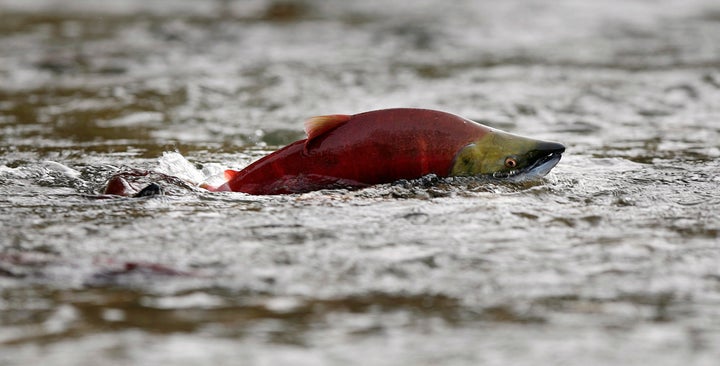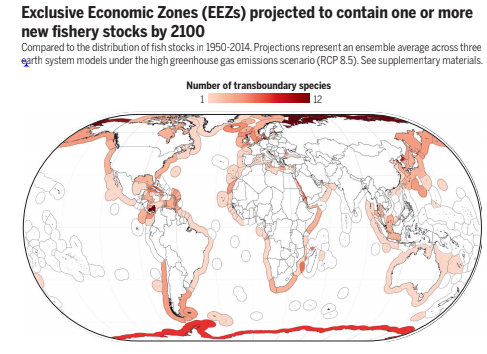
Fish are migrating more than 40 miles per decade as the oceans heat up, pushing populations into fisheries where other countries have exclusive rights and setting the stage for an era of surging international conflict, new research has found
Unless greenhouse gas emissions decrease rapidly, 70 countries are projected to contain one or more new fishery stocks in their exclusive offshore economic zones by the end of the century, according to a study published Thursday in the peer-reviewed journal Science. Making the findings more dire, there are no international organizations with the existing power to broker new deals to share the fish, raising the risk of overfishing and destructive tension between neighboring countries.
“It’s like two kids facing off after the last piece of cake,” said Malin Pinsky, the study’s lead author and an ecologist at Rutgers School of Environmental and Biological Sciences in New Brunswick, New Jersey. “If they both race for it, it’s likely they’re going to get frosting and cake smeared all over the table, and not as much cake for everyone ― as opposed to cutting the cake neatly and sharing it.”
The fishing wars have already begun. In the mid-1990s, increased warming in the Pacific Ocean pushed salmon south from British Columbia into United States waters, causing the so-called “salmon war” to erupt between Canada and the U.S. For years, Canadian fishermen tried to maximize their catch by targeting salmon heading south, leading to overfishing. By 1997, the conflict became physical as angry Canadian fishermen blockaded an Alaskan ferry and the British Columbia provincial government sued the U.S. The two countries only settled on new sharing agreements after the suit was dropped in 2000.
In 2007, Iceland and the Faroe Islands dramatically increased their annual quotas for mackerel as the striped, silvery fish’s massive schools shifted northward into the Nordic nations’ cooler waters. Scotland, backed by the European Union, fiercely protested the moves, and Scottish fishermen who depend on mackerel catches blockaded a Faroese ship, preventing it from unloading its haul. One Scottish politician accused Iceland and the Faroe Islands of “acting just like their Viking ancestors” by “plundering” fish stocks. The conflict lasted years, and ultimately derailed Iceland’s plans to join the European Union.

Even now, there is conflict between U.S. states. New Jersey has fought a years-long battle to convince federal regulators to increase its quotas for summer flounders, newly abundant in its waters since migrating north from North Carolina, where fishers traditionally depended on large hauls of the flatfish.
“These conflicts often don’t stay in fisheries. They spill over,” Pinsky said. “This isn’t a future problem.”
Yet it’s an issue with no current solution at the global level. The current legal framework for international regulation of fisheries does not account for fluctuating or changing distributions. The 1982 United Nations Convention on the Law of the Sea serves as the primary foundation for international fishing rules and obliges states to cooperate to establish conservation and management measures. But the convention does not cover the sudden influx of additional species into new fisheries, creating “a loophole that often allows newly-fished stocks to be heavily exploited before meaningful standards are developed,” Pinsky wrote in the paper.
Regional fishery management organizations, which are subject to the U.N. convention, would be “the most reasonable venue” for new sharing agreements between countries, Pinsky said. But there is no ongoing effort to convince regional fishery management groups to put stronger legal mechanisms in place to oversee species moving from one jurisdiction to another or increase information sharing between countries to better track how climate change is affecting the populations.
“These conflicts often don’t stay in fisheries, they spill over.”
- Ecologist Malin Pinsky
The Commission for Conservation of Antarctic Marine Living Resources could be a model for these groups going forward. The group forged agreements with neighboring regional fishery management organizations to monitor the movement of stocks across regulatory frontiers and worked with regulators to put precautionary rules in place over new fisheries, including no-take zones.
“They actually do have quite farsighted rules and mechanisms in place,” Pinsky said.
There are other potential solutions. The U.S., as part of its agreement to end the salmon war with Canada, agreed to pay into a salmon conservation fund to help balance out the losses from the population shift. That policy is known as a “side payment.” Another approach proposes allowing fishers to trade permits across national boundaries, so they can be compensated for losses by selling access to other fishers.
Pinsky worked with a team of five other researchers and social scientists to review historical examples of shifting species between countries and organizations. He partnered with Richard Caddell, a fishery policy scholar at Utrecht University in the Netherlands, to analyze current rules on sharing fish stocks around the world. He then compared fish stock movements for 892 different commercially-important fish and invertebrates to two different scenarios run through three separate global climate models ― one based on the current projections for increasing greenhouse gas emissions, and another more based on meeting the moderate Paris Agreement goal of only 2.6 degrees Celsius of warming above pre-industrial levels.
The projections showed grave warnings. Even under the lower temperature scenarios, between 40 and 50 countries would be at risk of fishing conflicts as one or more stocks appeared in their exclusive zones. With aquatic animals migrating on average 10 times faster than land creatures as a result of climate change, time for proactive policy planning is running out.
“Marine species are on the front lines of experiencing this,” Pinsky said. “Avoiding fisheries conflict ultimately provides more fish, more food and more jobs for everyone. There are really good reasons for addressing this now.”

